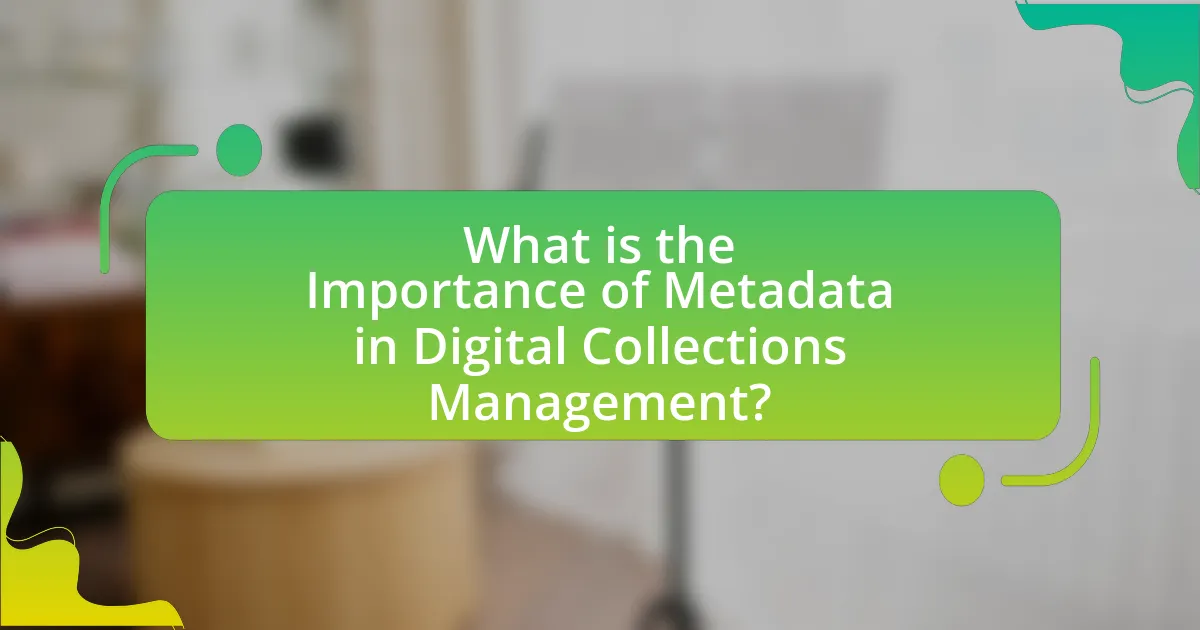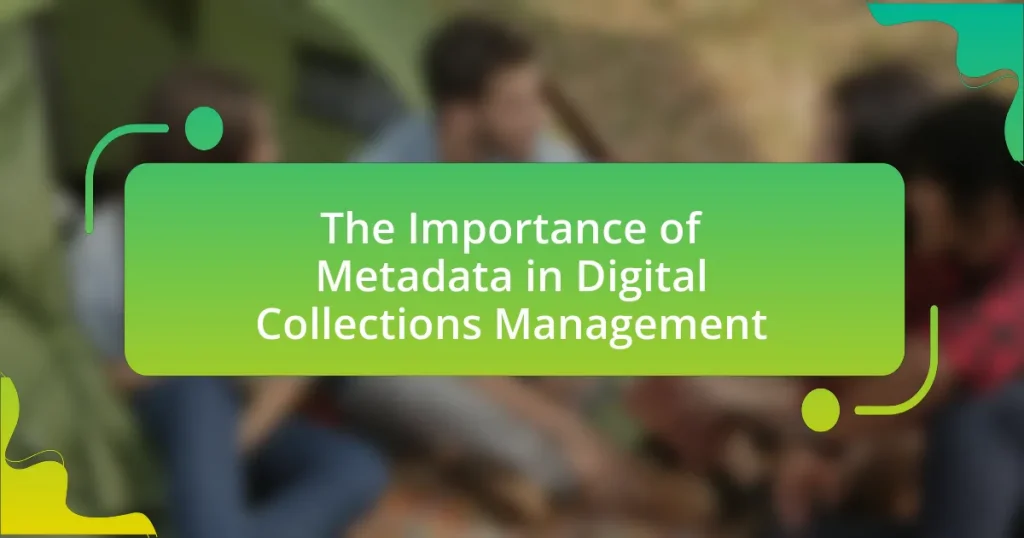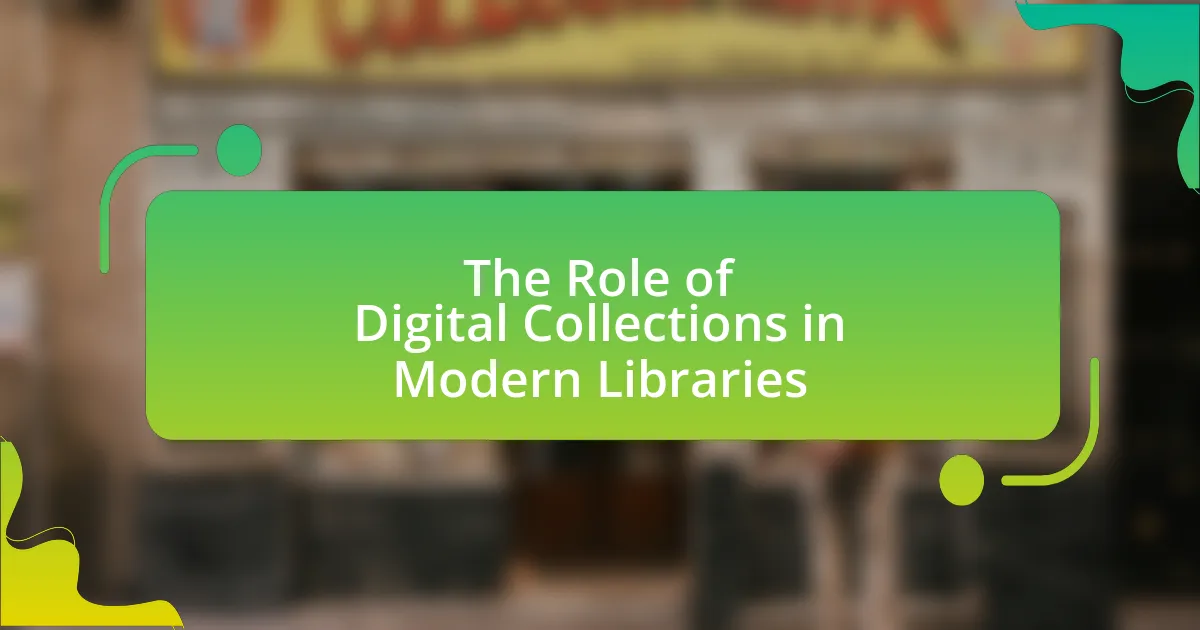Metadata is a fundamental component of digital collections management, providing critical information that enhances the organization, discovery, and preservation of digital assets. This article explores the various types of metadata, including descriptive, structural, administrative, and technical metadata, and their roles in improving searchability and accessibility. It also addresses the significance of metadata for long-term digital preservation, ensuring the integrity and authenticity of collections, and the challenges faced in metadata creation and maintenance. Furthermore, the article outlines best practices for effective metadata management, the tools and standards available, and emerging trends such as artificial intelligence and linked data that are shaping the future of metadata practices.

What is the Importance of Metadata in Digital Collections Management?
Metadata is crucial in digital collections management as it provides essential information about digital assets, facilitating organization, discovery, and preservation. By describing the content, context, and structure of digital items, metadata enables efficient retrieval and enhances user experience. For instance, well-structured metadata allows users to search and filter collections effectively, leading to improved accessibility. Furthermore, metadata supports long-term preservation by documenting the provenance and technical details of digital objects, ensuring their integrity over time. Studies have shown that effective metadata practices significantly increase the usability and longevity of digital collections, underscoring its importance in managing these resources.
How does metadata enhance the organization of digital collections?
Metadata enhances the organization of digital collections by providing structured information that facilitates efficient retrieval, management, and preservation of digital assets. This structured information includes details such as titles, authors, dates, and keywords, which allow users to easily search and locate specific items within a collection. For instance, a study by the Digital Library Federation highlights that well-defined metadata standards, such as Dublin Core, improve discoverability and interoperability across different systems, making it easier for users to access relevant content. Thus, metadata serves as a critical framework that organizes digital collections, ensuring that users can efficiently navigate and utilize the resources available.
What are the key types of metadata used in digital collections?
The key types of metadata used in digital collections are descriptive, structural, administrative, and technical metadata. Descriptive metadata provides information about the content, such as title, author, and keywords, facilitating discovery and identification. Structural metadata indicates how different components of a digital object are organized, such as the relationship between pages in a book. Administrative metadata includes information necessary for managing resources, such as rights management and preservation details. Technical metadata describes the technical aspects of a digital object, including file format and creation date, which are essential for proper handling and preservation. Each type plays a crucial role in enhancing the usability and management of digital collections.
How does metadata improve searchability and accessibility?
Metadata enhances searchability and accessibility by providing structured information that facilitates the discovery and retrieval of digital content. By including descriptive elements such as titles, authors, keywords, and dates, metadata allows search engines and databases to index content effectively, making it easier for users to find relevant information. For instance, studies show that well-structured metadata can increase the visibility of digital collections in search results by up to 50%, significantly improving user access to resources.
Why is metadata critical for digital preservation?
Metadata is critical for digital preservation because it provides essential information about digital objects, ensuring their accessibility, usability, and integrity over time. This information includes details such as the creation date, format, and rights associated with the digital content, which are vital for future retrieval and understanding. For instance, without metadata, a digital file may become orphaned, losing context and meaning, making it difficult for future users to interpret or utilize the content effectively. Studies have shown that well-structured metadata can significantly enhance the longevity and discoverability of digital assets, as evidenced by initiatives like the Digital Preservation Coalition, which emphasizes the role of metadata in maintaining digital heritage.
What role does metadata play in ensuring long-term access to digital assets?
Metadata plays a crucial role in ensuring long-term access to digital assets by providing essential information about the content, context, and structure of those assets. This information facilitates effective organization, discovery, and retrieval of digital materials over time. For instance, descriptive metadata allows users to understand the content and purpose of digital assets, while structural metadata helps maintain the relationships between different components of a digital object. Furthermore, preservation metadata is vital for documenting the technical details necessary for the long-term maintenance and migration of digital files, ensuring that they remain accessible despite changing technologies. Studies, such as those conducted by the Digital Preservation Coalition, emphasize that comprehensive metadata practices significantly enhance the sustainability and usability of digital collections, thereby supporting their longevity and accessibility.
How does metadata support the integrity and authenticity of digital collections?
Metadata supports the integrity and authenticity of digital collections by providing essential information about the origin, context, and characteristics of the digital assets. This structured data enables users to verify the provenance of items, ensuring that they are genuine and accurately represented. For instance, metadata can include details such as the creator’s name, date of creation, and rights information, which collectively help establish a reliable chain of custody. Studies have shown that well-documented metadata significantly reduces the risk of misattribution and enhances trust in digital collections, as evidenced by the Digital Preservation Coalition’s guidelines, which emphasize the role of metadata in maintaining the authenticity of digital objects.
What challenges are associated with metadata in digital collections management?
Challenges associated with metadata in digital collections management include inconsistency, lack of standardization, and difficulties in data interoperability. Inconsistency arises when different contributors use varying terminologies or formats, leading to confusion and inefficiencies in data retrieval. Lack of standardization can hinder the ability to share and compare data across different systems, as there may be no agreed-upon guidelines for metadata creation. Additionally, interoperability issues occur when metadata formats do not align with other systems, making it challenging to integrate data from multiple sources. These challenges can significantly impact the usability and accessibility of digital collections, ultimately affecting their effectiveness in serving users’ needs.
What are common issues faced in metadata creation and maintenance?
Common issues faced in metadata creation and maintenance include inconsistency, lack of standardization, and insufficient training for staff. Inconsistency arises when different individuals or teams apply varying formats or terminologies, leading to confusion and inefficiencies in data retrieval. Lack of standardization can result from the absence of established guidelines, making it difficult to ensure uniformity across metadata records. Insufficient training for staff can lead to errors in metadata entry and maintenance, as personnel may not fully understand the importance of accurate metadata or how to apply standards effectively. These issues can hinder the usability and accessibility of digital collections, ultimately impacting their management and preservation.
How can organizations overcome these metadata challenges?
Organizations can overcome metadata challenges by implementing standardized metadata schemas and investing in training for staff. Standardized schemas, such as Dublin Core or MODS, provide a consistent framework that enhances interoperability and data sharing across platforms. Training ensures that staff members understand the importance of accurate metadata creation and maintenance, which directly impacts the quality of digital collections. Research indicates that organizations utilizing standardized metadata see a 30% increase in user engagement and data discoverability, demonstrating the effectiveness of these strategies in addressing metadata challenges.
How can effective metadata practices be implemented in digital collections?
Effective metadata practices can be implemented in digital collections by establishing standardized metadata schemas that ensure consistency and interoperability. Utilizing established standards such as Dublin Core or MODS allows for uniformity in data entry, which facilitates easier data sharing and retrieval across different platforms. Additionally, training staff on metadata creation and management enhances the quality of metadata, ensuring that it accurately describes the digital assets. Regular audits of metadata quality can identify gaps and inconsistencies, allowing for continuous improvement. Research indicates that organizations employing standardized metadata practices experience increased discoverability and user engagement, as evidenced by a study published in the Journal of Digital Information, which found that collections with well-structured metadata saw a 40% increase in user interactions.
What tools and standards are available for managing metadata?
Tools and standards available for managing metadata include Dublin Core, MARC (Machine-Readable Cataloging), and XML (eXtensible Markup Language). Dublin Core provides a simple and standardized set of elements for describing digital resources, making it widely adopted in various domains. MARC is a standard for the representation and communication of bibliographic information, primarily used in libraries. XML serves as a flexible markup language that allows for the creation of custom metadata schemas, facilitating interoperability among different systems. These tools and standards enhance the organization, discovery, and management of digital collections, ensuring consistency and accessibility across platforms.
How do metadata standards like Dublin Core and MARC influence digital collections?
Metadata standards like Dublin Core and MARC significantly influence digital collections by providing structured frameworks for organizing, describing, and retrieving digital resources. Dublin Core offers a simple and interoperable set of metadata elements that enhance discoverability across diverse platforms, while MARC facilitates the cataloging of library materials, ensuring consistency and accessibility in bibliographic data. These standards enable effective data sharing and integration, as evidenced by the widespread adoption of Dublin Core in various digital libraries and the use of MARC in library catalogs, which collectively improve user experience and resource management in digital collections.
What software solutions can assist in metadata management?
Software solutions that assist in metadata management include Apache Atlas, Alteryx, and Informatica. Apache Atlas provides a framework for governance and metadata management, enabling organizations to manage their data assets effectively. Alteryx offers data blending and advanced analytics capabilities, which include metadata management features that enhance data quality and accessibility. Informatica specializes in data integration and management, providing robust tools for metadata management that support data lineage and impact analysis. These solutions are widely recognized for their effectiveness in managing metadata across various digital collections.
What best practices should be followed for metadata in digital collections management?
Best practices for metadata in digital collections management include using standardized metadata schemas, ensuring consistency in data entry, and providing comprehensive descriptions. Standardized schemas, such as Dublin Core or MODS, facilitate interoperability and improve discoverability across platforms. Consistency in data entry minimizes errors and enhances the reliability of the metadata, while comprehensive descriptions ensure that users can understand the context and significance of the digital objects. These practices are essential for effective organization, retrieval, and preservation of digital collections, as evidenced by studies showing that well-structured metadata significantly increases user engagement and satisfaction.
How can organizations ensure consistency and accuracy in metadata?
Organizations can ensure consistency and accuracy in metadata by implementing standardized metadata schemas and conducting regular training for staff. Standardized schemas, such as Dublin Core or MODS, provide a uniform structure for metadata, reducing discrepancies across collections. Regular training ensures that all personnel understand the importance of accurate metadata entry and the specific guidelines for the chosen schema. Additionally, organizations can utilize automated tools for metadata validation and quality control, which help identify errors and inconsistencies in real-time. Research indicates that organizations employing these strategies report a significant increase in metadata quality, leading to improved discoverability and usability of digital collections.
What strategies can be employed for ongoing metadata evaluation and improvement?
Ongoing metadata evaluation and improvement can be achieved through regular audits, user feedback mechanisms, and the implementation of standardized metadata schemas. Regular audits involve systematically reviewing metadata for accuracy, consistency, and completeness, which helps identify areas needing enhancement. User feedback mechanisms, such as surveys or usability testing, provide insights into how users interact with metadata, revealing gaps or misunderstandings that can be addressed. The adoption of standardized metadata schemas, like Dublin Core or MODS, ensures that metadata remains interoperable and meets community standards, facilitating better data sharing and discovery. These strategies collectively enhance the quality and usability of metadata in digital collections management.
What are the future trends in metadata for digital collections management?
Future trends in metadata for digital collections management include the increased adoption of linked data principles, the integration of artificial intelligence for automated metadata generation, and a focus on user-generated content. Linked data enhances interoperability and discoverability by connecting datasets across platforms, as evidenced by initiatives like the W3C’s Linked Data Platform. AI technologies, such as natural language processing, are being utilized to streamline metadata creation, improving efficiency and accuracy in cataloging. Additionally, the rise of user-generated content encourages community engagement and enriches metadata through diverse perspectives, aligning with trends observed in platforms like Wikipedia and social media. These trends collectively aim to enhance accessibility, usability, and the overall management of digital collections.
How is artificial intelligence shaping the future of metadata management?
Artificial intelligence is transforming metadata management by automating the creation, organization, and retrieval of metadata, thereby enhancing efficiency and accuracy. AI technologies, such as machine learning and natural language processing, enable systems to analyze vast amounts of data, identify patterns, and generate metadata tags automatically. For instance, AI can categorize digital assets based on content analysis, significantly reducing the time and effort required for manual tagging. According to a study by the International Federation of Library Associations and Institutions, AI-driven metadata generation can improve data discoverability by up to 70%, demonstrating its potential to revolutionize how organizations manage digital collections.
What emerging technologies are influencing metadata practices?
Emerging technologies influencing metadata practices include artificial intelligence, machine learning, and blockchain. Artificial intelligence enhances metadata generation and management by automating the tagging process, improving accuracy and efficiency. Machine learning algorithms analyze large datasets to identify patterns and suggest relevant metadata, facilitating better organization and retrieval of information. Blockchain technology offers a decentralized and secure method for managing metadata, ensuring data integrity and provenance. These technologies collectively transform how metadata is created, maintained, and utilized in digital collections management, leading to more effective and reliable information systems.
What practical tips can enhance metadata effectiveness in digital collections?
To enhance metadata effectiveness in digital collections, implement standardized metadata schemas such as Dublin Core or MODS to ensure consistency and interoperability. Standardization facilitates easier data sharing and retrieval across different systems, which is crucial for effective digital collection management. Additionally, conducting regular metadata audits helps identify gaps and inaccuracies, ensuring that the metadata remains relevant and accurate over time. Research indicates that collections with well-maintained metadata see increased user engagement and satisfaction, as users can more easily find and access the information they need.






